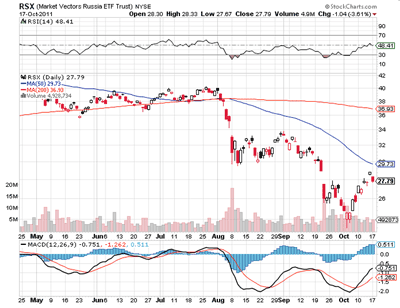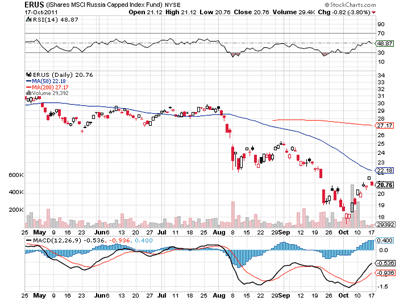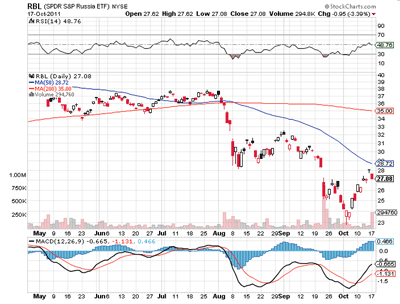Despite concerns about the current health of emerging markets like Russia, longer-term prospects remain promising, and four ETFs in particular offer the most direct, low-cost exposure to Russia’s economy and markets.
Although many emerging markets still have excellent growth prospects, they have been hammered in recent weeks thanks to a “risk-off” trade in equities. Broad funds targeting the emerging markets space—such as the Vanguard Emerging Markets VIPERs (VWO) or iShares MSCI Emerging Markets (EEM)—have fallen sharply in this time period, declining by nearly 16.8% in the past quarter alone.
While this may sound bad, it is nothing compared to the steep losses that some specific markets have been facing, especially those tied to natural resources. Russia in particular has been cast aside by many investors in this time frame, pushing shares of the economic juggernaut down by close to 25% in the past three-month period.
While these losses are obviously significant, one has to question whether it is worth abandoning the nation entirely due to this significant bump in the road. After all, investors must also consider Russia’s lousy demographic situation and the fact that the nation is still a one-trick pony whose economy is pretty much entirely dependent on commodity prices at this time.
Yet, despite these legitimate concerns, investors still have a number of reasons to be bullish on the economy going forward:
- Although Russia is highly dependent on commodities, it focuses on products that are vital to global growth and are unlikely to fall out of demand anytime soon.
- Furthermore, the country has greatly improved relations with a number of rapidly developing nations in both Europe and Asia, increasing its trade base for the future.
- Lastly, Russia has also made great strides to develop its technology and financial sectors, helping to further diversify the economy for the future.
Given these divergent trends, an investment in Russia could clearly go either way going forward. That is why investors need to be well aware of what caused the recent crash in Russian equity prices and some of the key events that could impact the country going forward.
Live and Die by Oil Prices
One of the key reasons for Russia’s dramatic decline in the past few months has been oil’s continued slump. Prices of Brent crude oil have fallen over the past few months, and hopes for increased demand in Europe are low, at best. As a result, Russia’s oil industry, which is a key driver of the national economy, has been extremely hard hit in recent weeks thanks to these fears of slumping demand.
In fact, Russia is actually the second biggest exporter and producer of oil in the world, while its natural gas exports lead the globe. Since Russia’s economy is so thoroughly dominated by energy commodities, the weakness in prices for these key products, as well as fears for a global slowdown, undoubtedly helped to crash the economy over the past few months.
Another item that investors need to be aware of is the likely return of Vladimir Putin to the presidency of the country. Putin was president from 2000-2008 and is the current prime minister due to constitutionally mandated term limits.
However, these limits only say that a person can’t be president for three consecutive terms, so Putin looks to regain control of the nation in elections next year. While his record on human rights and the tilt towards a “leader-for-life” situation are certainly troubling, no one can deny that he got results in the economy when he was president, helping to grow GDP six-fold during his reign.
Beyond this, the return of Russia’s strongman to the head role and the likely stability that this will bring to the country is likely to be good for markets in the long term.
Given these trends, and the likely boost to oil prices if Europe can ever get its act together, investors have to believe that Russian ETFs can return to prominence in the next few months.
In terms of gaining exposure to the country, options are limited in the stock space, but there are several ETFs that offer at least a few holdings in the nation. Beyond several BRIC funds that hold a decent amount of Russian securities, there are a few choices for those looking for direct exposure to the nation.
Next, we take a brief look at some of the options investors have in this interesting space.
Article Continues on Page 2
|pagebreak|Market Vectors Total Return Russia ETF (RSX)
RSX is the gold standard for Russian ETFs, as the product is by far the most popular and liquid fund in the space. The Van Eck product has close to $1.7 billion in assets, while trading volumes are over five million shares a day.
In terms of holdings, the fund is heavily concentrated in energy and materials companies, as these two sectors make up 37.3% and 27.4%, respectively. Expenses currently stand at 62 basis points a year, while dividends are slightly higher at roughly 0.7%.
For performance, RSX is down close to 10.8% over the past month and nearly 28% in the past quarter alone, suggesting that weakness in oil and global markets have taken their toll on investors in this fund.
iShares MSCI Russia Capped Index Fund (ERUS)
ERUS is iShares’ counterpart to RSX in the space, tracking the MSCI Russia 25/50 Index. The fund looks to follow the performance of equities in the top 85% of market cap range of securities listed on Russian exchanges.
Much like RSX, ERUS’ top holdings are to energy and materials, although this fund has a much bigger tilt towards energy. In fact, close to 55% of total assets go to energy, while about 15.6% go to materials, and another 13.8% to financials. Expenses for ERUS are 65 basis points a year, while dividends are 1.6% in 30-day SEC yield terms.
In terms of performance, ERUS is down about 9.2% in the past month and has declined by 27.6% in the past quarter.
NEXT: 2 Lesser-Known ETFs for Trading Russia
|pagebreak|SPDR S&P Russia ETF (RBL)
State Street’s entrant into the Russia ETF space is far less popular than the other two products, but it still offers an interesting slice of exposure nonetheless. The fund tracks the S&P Russia Capped BMI Index, which is a float-adjusted market cap index designed to define and measure the investable universe of publicly traded companies domiciled in Russia.
Much like its counterparts in the space, energy firms, at just over 50% of total assets, take the top spot, and are trailed by materials at 18.8%. Financials also make up a double-digit allocation, while a smattering of other sectors comprise the rest of the fund.
While RBL might not be the most popular, the fund is the cheapest, costing investors just 59 basis points a year in fees.
As for returns, RBL has lost about 10.5% in the past month and nearly 25.8% in the past quarter—in line with the other funds in the category.
Market Vectors Russia Small-Cap ETF (RSXJ)
For investors looking for a different way to invest in Russia, RSXJ could be it. The product shuns large-cap equities and instead invests in the small-cap segment of the Russian economy, giving the fund a unique risk/return profile.
Holdings are also vastly different, as the fund gives energy companies a weighting of “just” 14% in the portfolio. Top weightings instead go to materials at 20.4%, industrials at 18.8%, and utilities at 16.9%.
Although RSXJ does offer a unique slice of exposure, investors do end up paying for this with slightly higher fees, as costs come in at 0.67%.
Unfortunately, this exposure hasn’t produced very different results over the past few months, as this product is down about 10.7% in the past four weeks and close to 28% in the past quarter.
By Eric Dutram of ETFdb.com
























